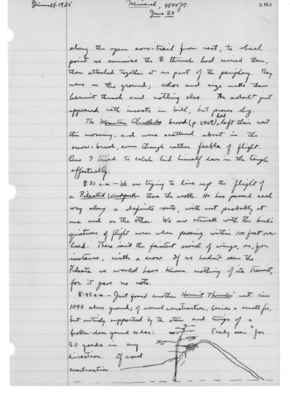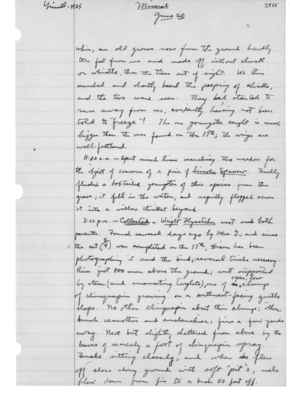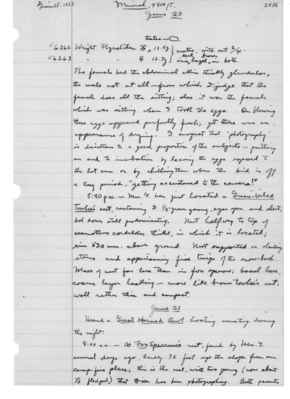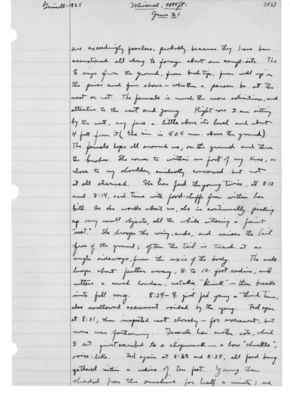Pages That Mention Joseph Grinnell
1925: Joseph Grinnell's field notes
S2 Page 28
Collector: Grinnell - 1925 Location: Mineral, 4800 ft. Date: June 20 Page Number: 2483
along the open cow-trail from nest, to which point we surmise the (female) thrush had carried them, then attached together at one part of the periphery. They were on the ground; color and size make them hermit thrush and nothing else. The adult just appeared with insects in bill, but proves shy.
The Mountain Chickadee brood (p. 2469) had left their nest this morning, and were scattered about in the snow-brush, even though rather feeble of flight. One I tried to catch hid himself down in the tangle effectually.
8:30 a.m. - We are trying to line up the flight of a Pileated Woodpecker thru the (unknown1). He has passed each way along a definite route, with nest probably at one end or the other. We are struck with the bird's quietness of flight even when passing within 100 feet over head. There isn't the faintest swish of wings, as, for instance, with a crow. If we hadn't seen the Pileate we would have known nothing of its transit, for it gave no note.
8:45 a.m. - Just found another Hermit Thrushes' nest: rim 1090 above ground; of usual construction, beside a small fir, but entirely supported by the stem and twigs of a broken-down young cedar. Easily seen for 50 yards in any direction. Of usual construction.
S2 Page 29
Collector: Grinnell-1925 Location: Mineral Date: June 20 Page Number: 2484
for the species. Bird was on, sitting very closely; put my hand within two feet of her, when she left for the ground, and trotted off hesitantly on the ground and over logs, but without uttering a note. Site is in heavy shade of firs and lodgepole pines, about 100 feet from edge of willow bog. Contents of nest, four helpless young, of almost exactly same size as those in other nest examined this morning.
10:10 a.m. - Yellow Warbler's nest just found by Mrs. G. in dense willow bed of creek bottom. Rim of nest 1580 mm. above ground; nest insecurely cobwebbed to several slender willow twigs which happened pass each other there. Surely, a very moderate breeze would have dislodged it. Female bird tripping very close about solicitously; male singing around in willow tops, both before and after our taking of the nest. The four eggs apparently but moderated incubated (about 1/2) and taken (set 1/4). Site of nest but 6 feet or so from creek which here runs in a deep channel beneath the interlacing willow tangle.
11 a.m. - We followed up a grouse "boonting"- traced it to somewhere overhead in a tract of large lodge pole pines. "Boonts" given in series of 4 to 6 audible notes - very low pitch, 2nd loudest, trailing off toward inaudible; so there may have been one or more "potential" throbs at the end that we couldn't hear. Having passed beneath the trees, we were retracing our steps, when with startling wing-
S2 Page 30
Collector: Grinnell-1925 Location: Mineral Date: June 20 Page Number: 2485
whir, an old grouse rose from the ground hardly ten feet from us and made off without cluck or whistle, thru the trees out of sight. We then marched and shortly heard the peeping of chicks, and the two were seen. They had started to run away from us, evidently having not been told to "freeze"! The one youngster caught is much bigger than the ones found on the 17th; the wings are well-feathered.
11:30 a.m. - Spent much time searching the meadow for the object of concern of a pair of Lincoln Sparrow. Finally flushed a bobtailed youngster of this species from the grass; it fell in the water, and rapidly flopped across it into a willow thicket beyond.
3:00 p.m. - Collected a Wright Flycatcher nest and both parents. Found several days ago by Mrs. G, and since the set (2/4) was completed on the 17th, Dixon has been photographing it and the bird; several trials necessary. Rim just 800 mm. above the ground; nest supported by stem (and innovating twiglets), one of an ^open, low clump of chinquapin growing on a southwest-facing gentle slope. No other chinquapin about this clump; other brush ceanothus and amelanchier; firs a few yards away. Nest but slightly sheltered from above by the leaves of scarcely a foot of chinquapin spray. Female sitting closely, and when she flew off close along ground with soft "pit"s, male flew down from fir to a bush 50 feet off.
S2 Page 31
Collector: Grinnell-1925 Location: Mineral, 4800 ft., Date: June 20 Page Number: 2486
6262 Wright Flycatcher (male) ^testes [illustration] 12.5 g 6263 [Wright] [Flycatcher] (female) 12.7 g } mates, with set 2/4. iris ^dark hazel ^brown in both.
The female had the abdominal skin thickly glandular, the male not at all - from which I judge that the female does all the sitting; also it was the female which was sitting when I took the eggs. On blowing these eggs appeared perfectly fresh; yet there was an appearance of drying. I suspect that "photography" is disastrous to a good proportion of the subjects - putting an end to incubation by leaving the eggs exposed to the hot sun or by chilling them when the bird is off a long period, "getting accustomed to the camera!"
5:40 p.m. - Mrs. G. has just located a Green-tailed Towhee's nest, containing 3 1/3-grown young, eyes open and alert, but down still predominating. Nest halfway to top of ceanothus cordulatus thicket, in which it is located; rim 520 mm. above ground. Nest supported on slanting stems and appertaining fine twigs of the snow-bush. Mass of nest far less than in fox sparrow; basal loose, coarse layer lacking - more like brown towhee's nest; wall rather thin and compact.
June 21 Heard a Great Horned Owl hooting something during the night.
8:00 a.m. - At Fox Sparrow's nest, found by Mrs. G. several days ago, hardly 75 feet up the slope from our camp-fire place; this is the nest, with two young (now about 1/3 fledged) that Dixon had been photographing. Both parents
S2 Page 32
Collector: Grinnell-1925 Location: Mineral, 4800 ft. Date: June 21 Page Number: 2487
are exceedingly fearless, probably because they have been accustomed all along to forage about our camp-site. The (male) sings from the ground, from bush-tips, from well up in the pines and fir above - whether a person be at the nest or not. The female is much the more solicitous, and attentive to the nest and young. Right now I am sitting by the nest, my face a little above its level and about 4 feet from it (the rim is 505 mm. above the ground). The female hops all around me, on the ground and thru the bushes. She comes to within a foot of my knee, as close to my shoulder, evidently concerned but not at all alarmed. She has fed the young twice, at 8:12 and 8:14, each time with food-stuffs from within her bill. As she works about me, she is continually picking up very small objects, all the while uttering a faint "seat." She droops the wing-ends, and raises the tail free of the ground; often the tail is turned at an angle sideways, from the axis of the body. The male hops about farther away, 8 - to 10 - foot radius, and utters a much louder, metallic "klink" - then breaks into full song. 8:29 - female just fed young a third time, also swallowed excrement voided by the young. Fed again at 8:31, then inspected nest closely - for excrement, but none was forthcoming. Female has another note, which I at first ascribed to a chipmunk - a low "chuckle", voice-like. Fed again at 8:32 and 8:34, all food being gathered within a radius of ten feet. Young then shaded from the sunshine for half a minute; one




